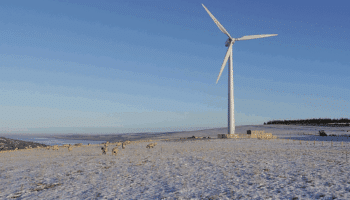- Energy
A large solar plant in California is closing – what does it mean for solar power?

Note: This article was updated on 4 July 2025 to describe concentrated solar’s role in heating.
Deep in California’s Mojave Desert, south of Las Vegas, you’ll find three brilliant towers rising from the sand, each ringed by a shimmering array of mirrors. This is the Ivanpah Solar Electricity Generating System. Ivanpah opened in 2014 to much fanfare, its construction partly funded by the U.S. government. Many at the time saw Ivanpah as a vision of a possible solar-powered future.
Earlier this year, Ivanpah’s operators announced that the plant is scheduled to at least partly close in 2026, less than halfway through its expected lifetime – saying that doing so would save money. The news has galvanized a lot of activity from renewable energy’s opponents, eager to pounce on what they see as a failure of technology and government investment in it. Many have used Ivanpah to criticize solar power as a whole.
However, these sorts of claims are misleading, because Ivanpah generates electricity very differently from how solar panels do. We can’t use Ivanpah’s closure to judge solar power or renewables at large. Furthermore, the technology that powers Ivanpah has evolved since the plant was built.
To better understand why, let’s take a closer look at Ivanpah – how the plant works, why it might be closing, and some of the claims that have been made about it.
Main Takeaways:
- Ivanpah relies on a type of solar power called concentrated solar power (CSP), which generates electricity by reflecting sunlight upon a central location to heat a fluid and spin a turbine.
- Although many online claims imply that Ivanpah’s closure reflects poorly on solar power as a whole, these claims are misleading. CSP plants operate very differently from the more common photovoltaic (PV) solar panels.
- When Ivanpah was built in the early 2010s, both CSP and PV were relatively expensive. In the decade since, costs of both have plummeted, but solar PV has become significantly cheaper than CSP.
- CSP has evolved since Ivanpah was built in the early 2010s. A CSP plant can store energy, which solar PV panels cannot. CSP plants are still operating elsewhere, with new plants still under construction. Additionally, the technology has other uses, like industrial heating.
Ivanpah isn’t a typical solar farm
When you think of solar power, you might imagine solar panels that line rooftops or solar farms. These are known as photovoltaic (PV) solar panels. It’s important to note that Ivanpah doesn’t use solar PV. Ivanpah generates a very different form of solar power – a form called concentrated solar power (CSP).
Many claims have simply labeled Ivanpah as ‘solar’ or looped it in with ‘net zero’ without providing necessary context. This is misleading, because as we’ll explain, PV and CSP do not work in the same way.
Look at an image of Ivanpah (Figure 1), and you’ll notice a few elements that you won’t see in a typical solar farm: a trio of 140 meter (459 foot) towers, each surrounded by sprawling concentric rings of mirrors, also called heliostats. These mirrors are precisely placed to reflect sunlight onto the heights of a tower. The vast sea of mirrors around each tower means that the towers receive a lot of concentrated sunlight – as CSP’s name suggests.
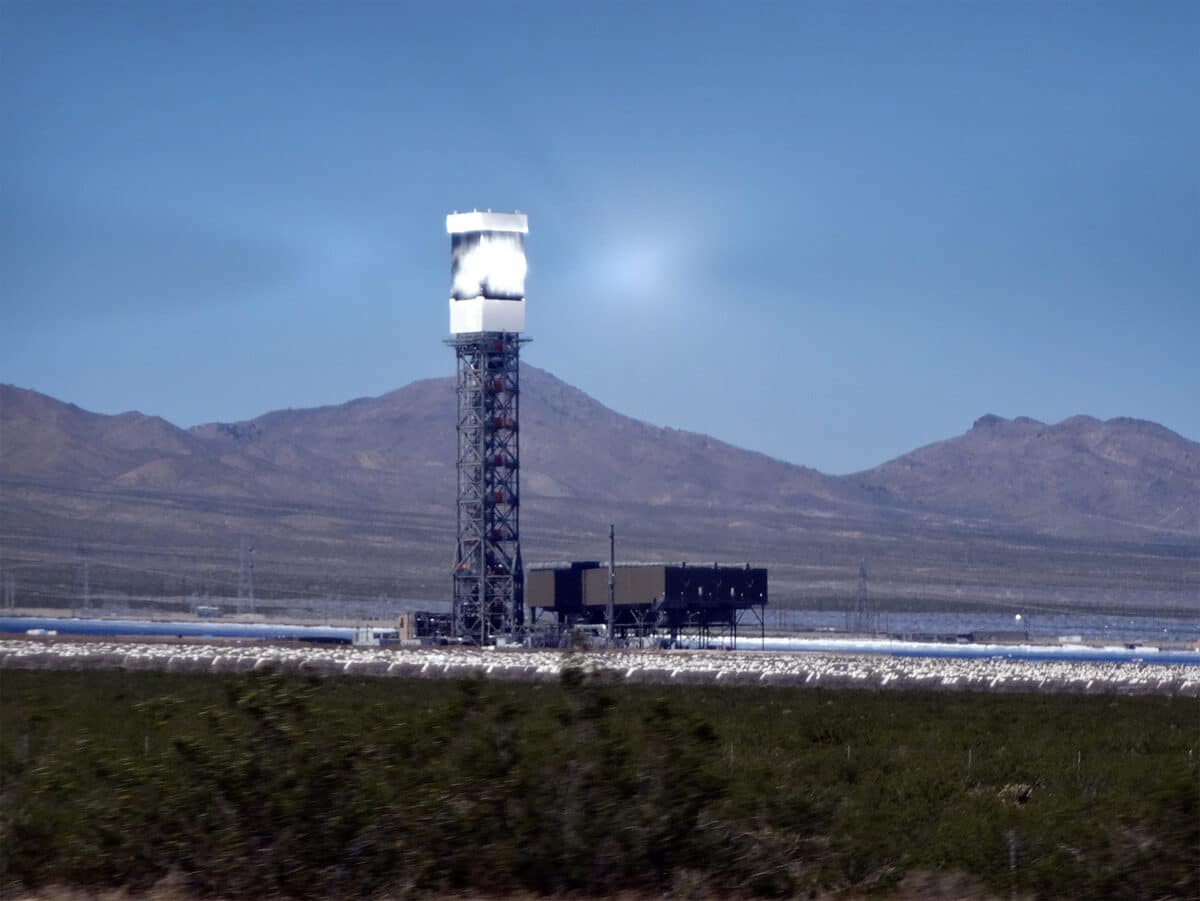
Each tower contains fluid – water, in Ivanpah’s case. The concentrated light heats up the fluid, converting it into steam. This steam then rotates a turbine – this is how Ivanpah generates electricity.
Not all CSP plants contain monolithic towers like Ivanpah’s. Most actually take the form of curved mirrors lined up in long ‘troughs’. A long line of fluid runs down the middle of each trough, and each trough’s mirrors concentrate sunlight on its tube and heat the fluid inside (Figure 2).
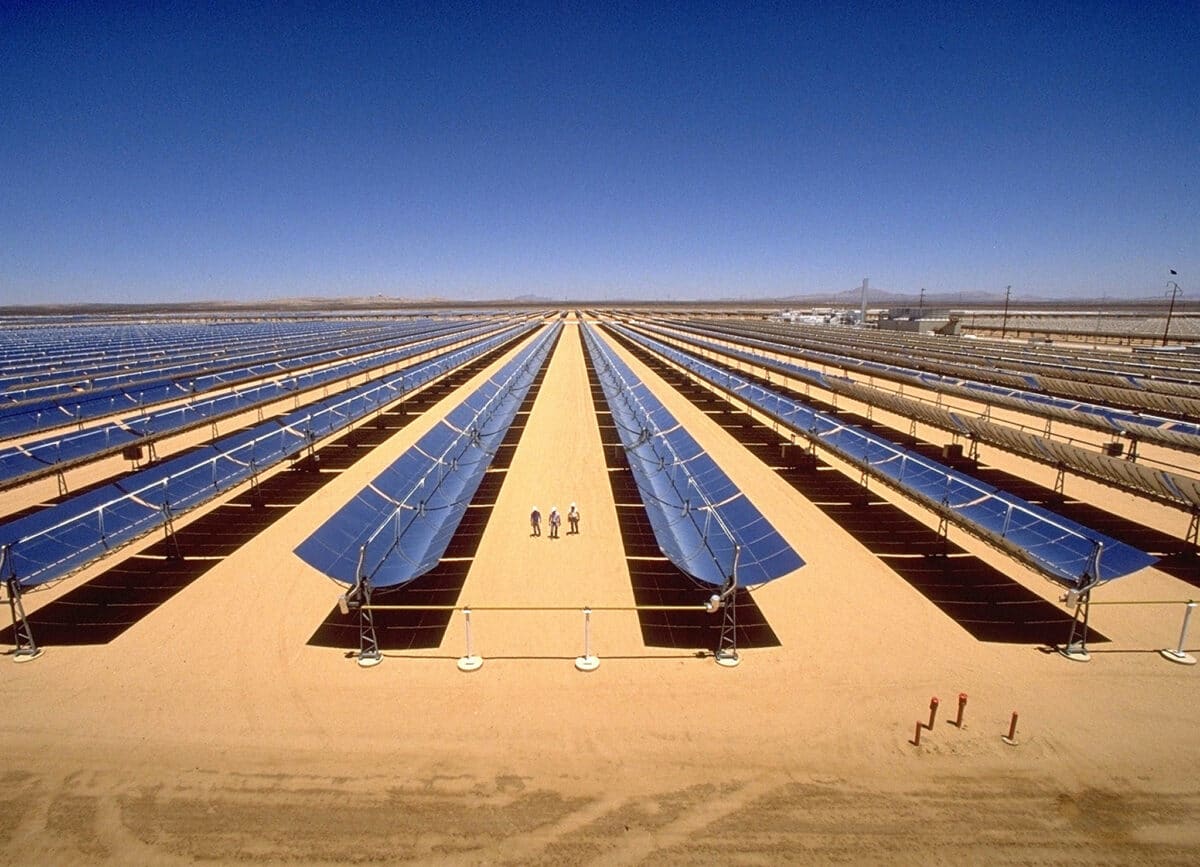
There are a few other designs, but towers and troughs are the most common. Towers are more efficient than troughs, but troughs can operate at lower temperatures[1].
A CSP plant is quite different from a PV solar farm. PV solar panels are not designed to be mirrors – electricity is generated within the panels themselves. As sunlight strikes a PV panel, it energizes electrons inside that flow out as electricity.
Meanwhile, a CSP plant generates electricity in a central location, outside its ‘panels’. By relying on a separate turbine, CSP facilities are less like solar farms and more like fossil fuel or nuclear power plants, which generate electricity in much the same way.
The two technologies are very different – so are their respective costs, advantages, and disadvantages. The only thing that CSP and solar PV really have in common is that they derive their power from sunlight. So, claims that cite Ivanpah’s potential closure to criticise solar PV are misleading.
Now, we’ll look at other misleading claims surrounding Ivanpah.
No evidence that Ivanpah is a ‘major killer of birds’
Ivanpah was built between 2010 and 2013 and began generating electricity in 2014. In the beginning, the plant faced a number of difficulties, and media coverage of the plant tended to be quite negative. One of the biggest stories was that birds kept flying into the plant’s concentrated sunbeams.
When news emerged of Ivanpah’s closure more than a decade later, many celebrating the plant’s closure were quick to single out the plant’s purportedly ‘high rate of bird deaths’. One post that has garnered more than 2.3 million views on X claims that the facility has ‘incinerated’ more than 60,000 birds in its lifetime. A video widely spread by Ivanpah’s opponents claims that the facility kills “6,000 birds a year” and labels it the “birdpocalypse”.
The exact number of birds who met unfortunate fates at Ivanpah isn’t certain. One early “back-of-the-napkin-level” estimate held that Ivanpah was responsible for about 28,380 bird fatalities each year. Later, more thorough estimates revised that number down, to 6,000 or 3,500.
It’s very difficult to measure bird fatalities – even if humans carefully comb through the facility and count every fallen bird, they’re almost certain to miss some that scavenging animals have reached first.
It’s easy to get lost in these numbers, and even 3,500 bird deaths may seem like a lot. But these figures may look different given context – billions of birds die in the U.S. each year. According to a 2015 study that combined the results of several other studies, millions of birds in the U.S. die each year from electrocutions, hundreds of millions die from colliding with buildings, and billions die from domestic cats[2].
In comparison, bird deaths from energy sources like Ivanpah are a drop in the bucket. But what if we narrow our focus to energy sources anyway?
A 2016 estimate suggested that 0.7 to 3.5 birds died at Ivanpah for each gigawatt-hour of electricity the plant produced (a gigawatt-hour is enough to power about 160 average Californian homes for a year). According to estimates for the year 2009, Ivanpah’s casualty count is higher than the 0.27 bird deaths per gigawatt-hour attributed to wind turbines and the 0.42 attributed to nuclear power, but significantly lower than the 5.18 attributed to fossil fuel electricity[3].
Any bird deaths are certainly unfortunate, and the data is far from conclusive, but what data we do have suggests that it’s misleading to single out Ivanpah for bird deaths among other sources.
It is true, however, that deserts are thriving ecosystems – far from the barren lands as which they’re often portrayed. Contrary to what many renewable energy opponents’ claims imply, however, solar energy builders are well aware of this. They’re often mandated by law to reduce their impacts on local wildlife.
For example, Ivanpah’s builders tried to mitigate their own impacts by, for example, building fences to keep desert tortoises away from the mirrors.
Ivanpah performed well, but CSP plants like it are now far more expensive than PV solar panels
When Ivanpah began operating in 2014, the plant struggled with suboptimal performance. In its first year of operation, Ivanpah generated under 50% of its capacity, significantly lower than the anticipated 70%. But Ivanpah’s operators made adjustments, and the plant’s performance steadily improved over the following years. By 2017, Ivanpah was operating more or less as expected, close to the 70% mark, and its output continued to improve in the following years.
Many renewable energy opponents have tried to portray Ivanpah as unreliable – some claims have stated that Ivanpah wasn’t generating as much electricity as planners had anticipated. However, these claims are cherry-picking data from the first several years of the plant’s life. Many power plants encounter difficulties when they start up.
Why, then, is Ivanpah set to wind down? The real story behind Ivanpah’s closure probably wasn’t the plant itself – it’s everything else around it. Ivanpah was one of the world’s first CSP plants. It was built in part to help support the development of the technology.
But, as Taha Manzoor, Assistant Professor of Mechanical Engineering at the University of Alberta, noted to Science Feedback, the state of solar power looks very different now than it did when Ivanpah was built:
“Solar PVs became very cheap in the meantime, and CSP could no longer directly compete with those technologies which could directly convert to electricity.”
Indeed, both CSP and solar PV prices have fallen considerably since the early 2010s (Figure 3). But solar PV prices have fallen more quickly – indeed, it’s now generally cheaper to generate electricity with solar PV than it is to generate the same electricity with fossil fuels.
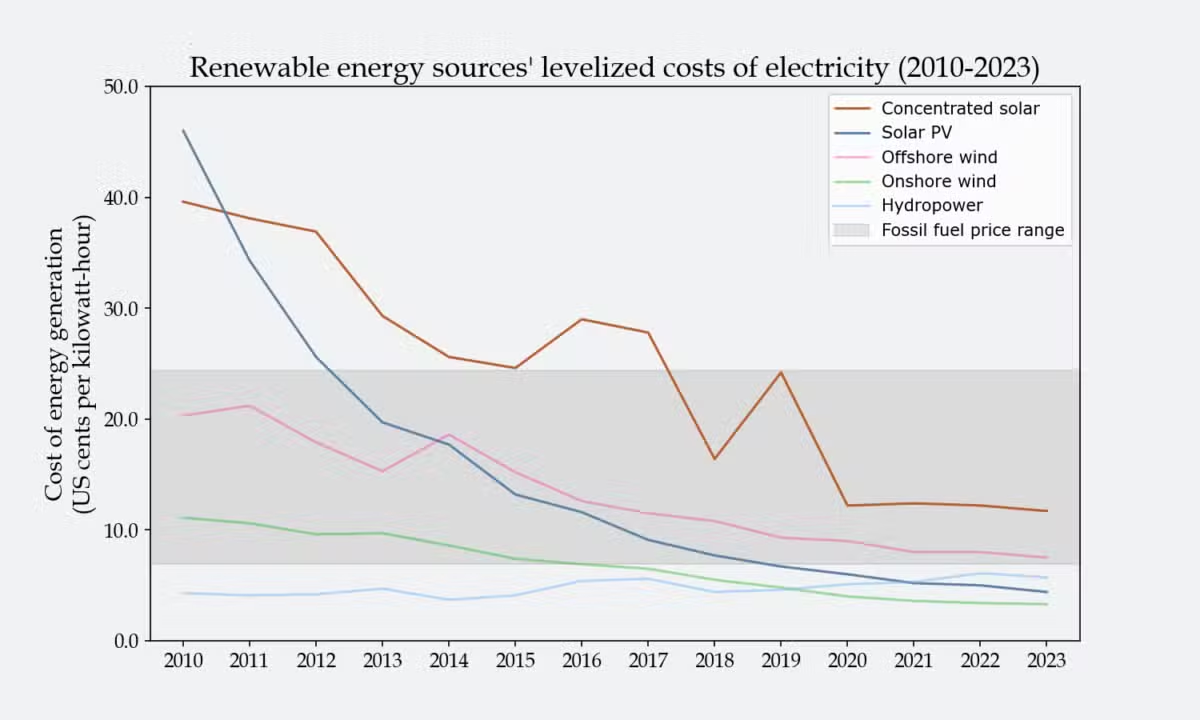
PV solar panels have become so cheap in part due to economies of scale – the world can now mass-produce PV solar panels. This is why it’s relatively easy for a building owner to install solar panels on their roof. The same can’t be said for CSP facilities, which require many specialized moving parts. Moreover, it’s easier to upkeep a PV solar farm than a CSP plant, which requires staff to continuously be on site[4].
Energy prices are more complex than this one cost (as we’ve covered in a past article), but it is generally true that a lower cost makes a source more appealing to build.
Is concentrated solar power a viable source of energy?
If that’s the case, then doesn’t Ivanpah’s fate reflect poorly on CSP?
We can’t answer that question for certain, but we can say that even if Ivanpah closes, it won’t spell immediate doom for CSP – other CSP plants continue to operate elsewhere in the world.
As of March 2025 (Figure 4), there were about 7.3 gigawatts of CSP in operation around the world (mostly in Spain, the U.S., and the Middle East), with 3.4 gigawatts more under construction (mostly in China). Combined, that’s still less than one percent of the 1,865 gigawatts of total solar power operating worldwide at the end of 2024, according to the International Renewable Energy Agency (IRENA).
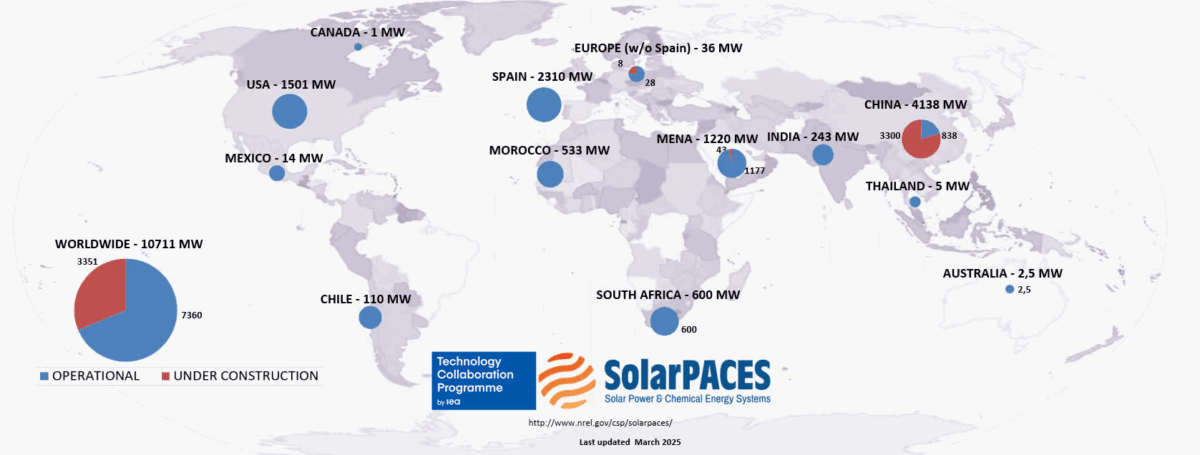
For comparison, Ivanpah represents 0.37 gigawatts of capacity – not a small amount, but certainly not the majority of CSP in the U.S., let alone the world.
Partly because Ivanpah was one of the first CSP plants, it didn’t benefit from some of the advancements the field has seen since. Ivanpah’s mirrors heated up water, but if you swap out the water for a fluid that can hold its heat for a longer period of time – a fluid like molten salt – you can effectively store that heat for days.
This means that a CSP plant can store energy, something solar PVs cannot do without the aid of something like a battery. For example, you can heat up your molten salt when the sun is out, then release that heat to generate electricity at night or when it’s overcast, when solar PVs don’t work as well.
Ivanpah couldn’t do this – Manzoor noted to Science Feedback that this sort of storage wasn’t on many energy planners’ minds when the plant was built – but many other CSP plants today can.
Even if CSP can’t compete with solar PVs as a source of electricity, the technology is still a useful way of creating very high temperatures without burning greenhouse-gas-spawning fossil fuels. As Manzoor told Science Feedback, this is where a lot of research in the field is headed now:
“The conversation shifted away from producing electricity and making systems more cost-effective or efficient for electricity production, and it moved towards heat production and keeping it low-cost.”
Manzoor told Science Feedback that a lot of industries are interested in using concentrated solar for heat. Industrial heating may not seem particularly glamorous, but the International Energy Agency estimates that industrial heating accounts for about one-fifth of the world’s energy use, and it’s especially reliant on fossil fuels, because there aren’t many alternatives for creating very high temperatures. Concentrated solar is one alternative.
Part of developing a new technology is learning where that technology succeeds and where it doesn’t work quite as well. CSP is a good example of this process.
What happens next at Ivanpah?
Due to how the U.S. electrical system is set up, Ivanpah is operated by a company named NRG Energy, which contracts out the electricity the plant generates to utilities, which in turn bring it to customers, like family homes. Two of Ivanpah’s towers are contracted to one utility, PG&E; these two are scheduled to close by 2026.
The third tower is contracted to a different utility, SCE; its fate remains uncertain, and it’s possible that it may continue to operate beyond 2026. (SCE confirmed to Science Feedback that negotiations are still ongoing, as of this writing.)
Even if the third tower also does close, the future of the site is uncertain. (Science Feedback asked NRG Energy for comment and did not receive a response.) However, even if the third tower does fully close, it’s too soon to claim that the site will simply be abandoned, as some have speculated.
For example, there’s been speculation that Ivanpah’s site may be converted for PV solar panels – it is located in one of the sunniest places in the Americas, after all.
References
- 1 – Shahabuddin et al. (2021) A critical review on the development and challenges of concentrated solar power technologies. Sustainable Energy Technologies and Assessments.
- 2 – Loss et al. (2015) Direct Mortality of Birds from Anthropogenic Causes. Annual Review of Ecology, Evolution, and Systematics.
- 3 – Sovacool B. (2013) The avian benefits of wind energy: A 2009 update. Renewable Energy.
- 4 – Alami et al. (2023) Concentrating solar power (CSP) technologies: Status and analysis. International Journal of Thermofluids.



